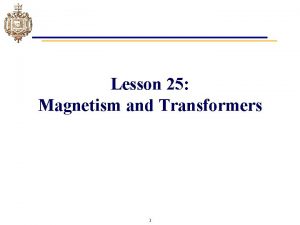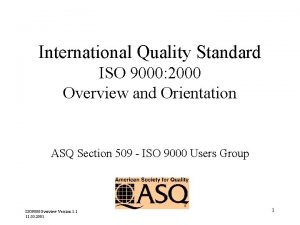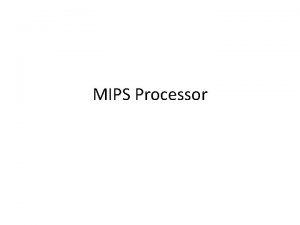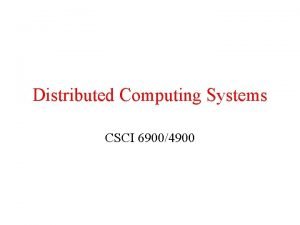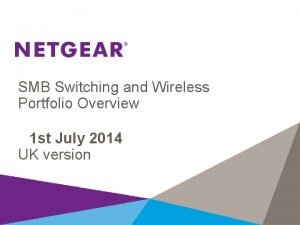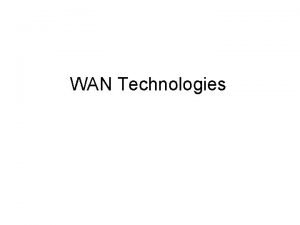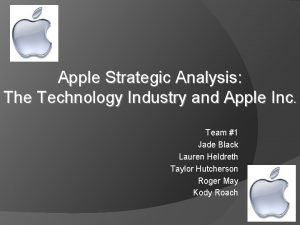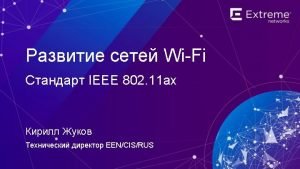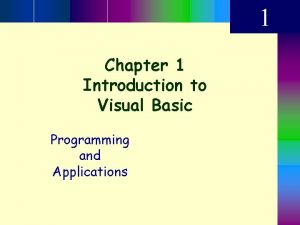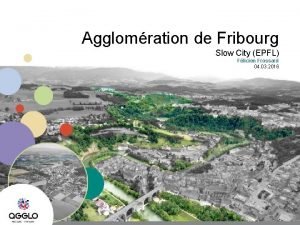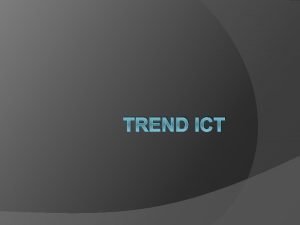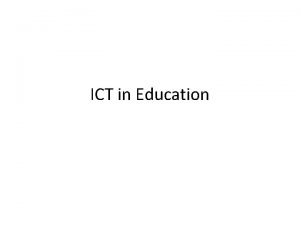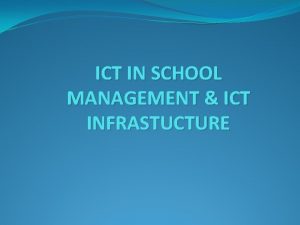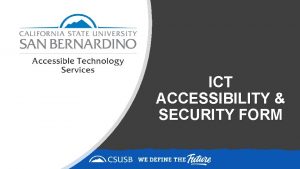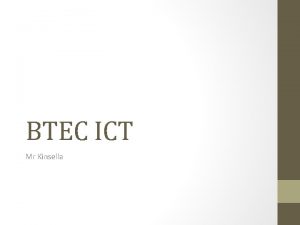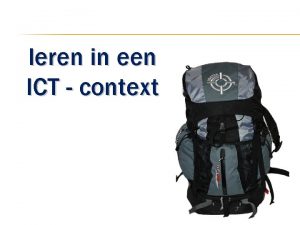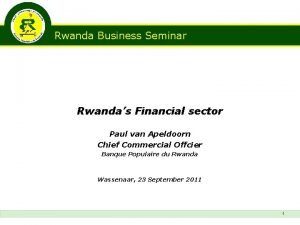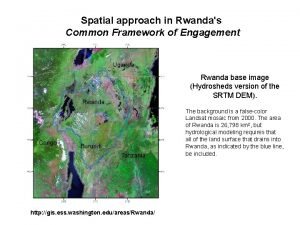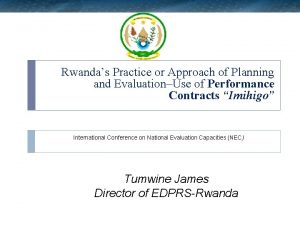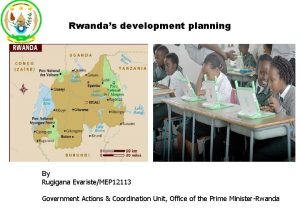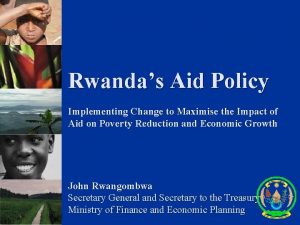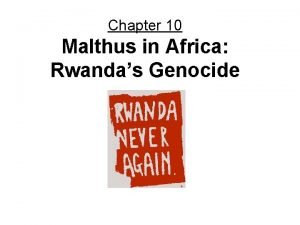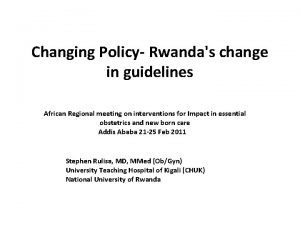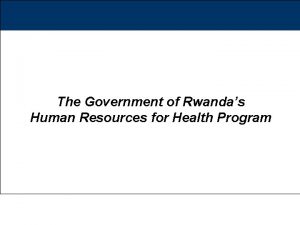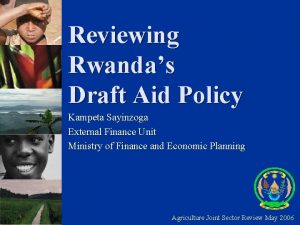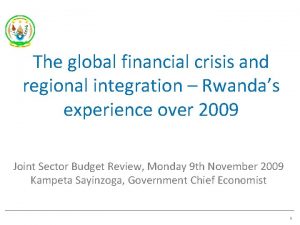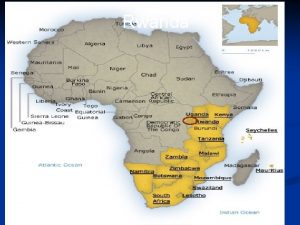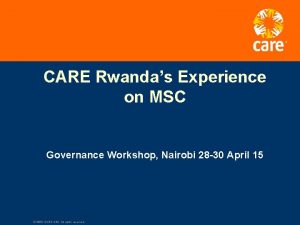Overview of Rwandas ICT Context Dr Flicien Usengumukiza




























- Slides: 28

Overview of Rwanda’s ICT Context Dr. Félicien Usengumukiza Senior Research Fellow Institute of Policy Analysis and Research (IPARRwanda) felicien. usengumukiza@ipar-rwanda. org Kigali, July 28 th, 2009

Contents • Introduction • The role of ICT in Economic development • Situational Analysis of ICT sector in Rwanda • The place of ICT in implementation of Vision 2020 program • SWOT Analysis of ICT sector in Rwanda • Summary and Recommendations

EDPRS, 2012 MDGs, 2015 Regional and International Economic Integration Productive and Market oriented Agriculture Infrastructure Development A Private sector-led Economy HRD and Knowledge based Economy Good Governance and a Capable State Rwanda’s Economic Development is based on clear and defined program ICT is a crosscutting area of Vision 2020 VISION 2020

ICT is an engine of economic performance for countries A reduction of transaction costs and times can help developing countries to take advantage of the opportunities resulting from trade liberalization. ICT has drastically cut long-standing obstacles to communication: time and distance. New communication technologies allow companies to source inputs independent of location. Reduction of transaction costs Increase productivity New trade opportunities Access to knowledge Increase competition Better communication ICT can also facilitate the rapid growth foreign direct investment (FDI) allowing global business management along the whole supply-chain through effective information and communication networks. The ICT-induced changes are transforming the rules of competition and giving rise to new types of competitive strategies: innovation-driven competition, time-based competition; mass customization; lean manufacturing, and demand-driven, built-toorder products (Fine, 1998).

ICT Competitiveness refers to a country’s capacity to exploit Information and communication technology in order to effectively participate in the global information economy. ICT Infrastructure ICT Environment ICT Competitiveness ICT Laws Human Resources 5

… and investments in SSA are mostly concentrated on ICT Telecom FDI versus Total FDI in SSA (2000 -2004) Telecom FDI, 20 Other FDI, 38 35% of total FDI in SSA was from telecom Source: World Bank WDI (2007)

All over the world, the Mobile Phone witnesses a spectacular penetration rate in one decade Global ICT Development, 1998 -2008 Source: International Telecommunication Union, 2008

As in many other countries, Rwanda recorded a spectacular increase rate of Mobile phone in one decade ICT Penetration in Rwanda (2000 -2009) Source: RURA, 2009

In comparison with its counterparties of the EAC, Rwanda is not yet attractive in terms of ICT penetration ICT Penetration in the EAC Countries, 2008 Source: ITU, ICT indicators, 2009

Fixed phone penetration is growing slowly even in many cases decreasing. Rwanda remains on the bottom of the list of EAC Countries 10

…. and Mobile phone penetration is growing rapidly in all countries and Kenya is above the African average. Mobile phone penetration in EAC Countries, 2000 -2008 11

Internet is also growing significantly particularly in Uganda. Internet penetration rate in EAC Countries, 2000 -20008 10 9 Kenya 8 Uganda 7 Africa 6 5 4 Rwanda 3 2 Tanzania 1 Burundi 0 2001 2002 2003 2004 Source: ITU, 2008 12 2005 2006 2007 2008

Mobile phone and internet penetration rate reached more than 1000% in EAC countries in one decade % of Mobile phones penetration in 2000 -2008 % of Internet penetration in 2000 -2008 13

As ICT network infrastructure is currently concentrated in Kigali City, ICT penetration rate is also higher in Kigali in comparison with Provinces 14

Due to ICT market liberalization, the monopoly spirit is broken with participation of different companies to the market. Number of telecom network operators and their respective number of subscribers Service Fixed Telephony Mobile Telephony Internet Service Provision Pay-TV Licensed Operators Rwandatel MTN Rwandacell Artel International* MTN Rwandacell Rwandatel ISPA MTN Rwandacell New Artel Altech Stream Rwanda Value Data Rwanda* Star Africa Media* Greenmax* Augere Rwanda* Comium* GTV Star Africa Media Tele 10 Number of Subscribers 16, 770 82 0 1, 158, 674 163, 963 4, 187 67 4, 021 151 19 0 0 0 617 5, 105 1, 543 Source : RURA, December 2008 Market share (%) 99. 5% 0% 87. 6% 12. 4% 49. 5% 0. 79% 47. 6% 1. 78% 0. 22% 0% 0% 0% 8. 49% 70. 26% 21. 23%

The more ICT Market enters into open competition, the more consumers are getting better services. ICT Basic services and tariffs Basic service per minute local call Fixed line usage tarrifs Fixed line installation charges Mobile contract usage tarrifs - MTN Mobile contract usage tarrifs - Rwandatel Mobile prepaid usage tariffs - MTN Mobile prepaid usage tariffs -Rwandatel Mobile phone handset cost 2004 2005 14 30, 000 104 14 30, 000 114 133 147 2006 33 30, 000 114 50 147 55 2007 33 30, 000 114 50 147 55 90, 000 2008 2009 proj. 33 30, 000 81 70 100 80 12, 000 45, 000 20, 000 35, 000 190, 000 200, 000 20, 000 35, 000 Internet Fixed line internet usage tariffs - MTN Fixed line internet usage tariffs - Rwandatel Mobile phone internet usage tariffs - MTN Mobile phone internet usage tariffs - Rwandatel Broadband Internet Fixed line internet usage tariffs - MTN Fixed line internet usage tariffs - Rwandatel Mobile internet usage tariffs - MTN Mobile internet usage tariffs - Rwandatel The increase in mobile phone services has been accompanied by decrease of costs of connections and handsets RURA, 2009 16

ICT remains the most attractive area for Foreign Direct Investment Rwanda’s Investment by sub-sector, 2006 Source: RDB/RIEPA, 2007 17

To this end, ICT has a significant impact to Socio Economic Performance to the country. This trend has also a positive impact to the economic growth ICT Sector Contribution to GDP, 2005 ICT Expenditure, 2005 -2012 Source: MINECOFIN, 2009 Source: TMG, Inc. , 2008 Socio Economic Indicators 1. Total Investment 2. Investment revenue 3. Taxes 4. Direct job creation 5. Indirect job creation 6. Universal Access Fund 2003 2004 2005 2006 3, 723, 085, 000 2, 306, 143, 000 5, 665, 153, 000 5, 026, 461, 000 15, 663, 469, 000 20, 056, 201, 000 18, 812, 518, 000 33, 144, 313, 000 3, 735, 804, 213 6, 512, 211, 986 6, 607, 008, 574 9, 121, 399, 468 128 131 145 152 1, 450 2, 600 3, 560 5, 820 171, 774, 695 166, 202, 866 295, 344, 085 Source: Nsengiyumva Albert et al. , Pro-Poor ICT Project Report – Rwanda: A Community-driven Network , July, 2007

In the framework of Vision 2020, Go. R is committed to use ICT in most of its activities in order to facilitate the rapid socio-economic development Agricultural Based Economy Kigali Metropolitan Network Knowledge Based Economy By 2020 NICI III NICI IV 1. Education 2. Human Resource Development Kalisimbi Project 3. Infrastructure, Equipment and Content 4. Economic Development 5. Social Development EASSY Project 6. E-Government and E-Governance Rwanda National Backbone Project 7. Private Sector Development 8. Rural and Community Access 9. Legal, Regulatory and Institutional provisions and standards 10. National Security Law and order Regional Communication Infrastructure Project Kigali ICT Park National Data Center E-Government

The EASSY Project to which Rwanda is integrated will contribute significantly to Rwanda’s integration to the world economy. The implementation of this project will allow Rwanda to become in ICT hub in the region 20

Although the NICI II is mostly on Infrastructure phase, Go. R recorded a good number of achievements. NICI 2010 Implementation progress 11% 24% Implemented Under implementation Have not started 65% Source: RITA, Mid-term Evaluation of the NICI 2010 Implementation for RITA, December, 2008 21

Through NICI program, most of activities are now based on E-Sector E-Education E-Health: - An open-source Medical Records System that tracks patient-level data - Trac. Plus and TRACnet – Monthly monitoring of infectious diseases including HIV/AIDS, TB, and Malaria - Telemedicine – Information and communication technology (ICT) used to deliver health and healthcare services - Mobile e-Health- use of mobile technology in improving health delivery in Rwanda - Health Management Information Systems (HMIS) – systems that integrate data collection processing, reporting, and use of the information for programmatic decision-making. - One Laptop per Child project: 100, 000 computers distributed to different primary schools - E-Schools in secondary school - Regional ICT Training and Research Center (RITC) - E-Learning - Distance Learning - Rwanda Education and Research Network - GIS, Rwanda Development Gateway

Through NICI program, most of activities are now based on E- Sector (Cont’d) E-Government - Fiber optic Installation, connectivity of a good number of schools, hospitals and other public institutions E-Agriculture - Agricultural Management Information System (AMIS) is an exchange platform for all stakeholders of the agricultural and livestock sector - Public Access Channels (12 Tele centers - Desks are already operational) - Kigali ICT Center - Smart National Cards, ID, E-business - E-soko project seeks to empower farmers to enable them make more informed market pricing decisions and ultimately more successful farming

Institutional arrangement Ministry in Charge of Science, Technology and Research RDB/RITA The development of ICT sector needs cooperation of these institutions. Ministry of Infrastructure RURA

Although the country witnesses a good number of challenges, the opportunities are also considerable and the future is promising ICT SWOT Analysis WEAKNESSES STRENGTH Strong political will in support of ICT Existing of National ICT Policy, NICI ICT sector budget is on par with OECD countries at 1. 6 percent, far above the African average Smallness of the countries would facilitate ICT Network infrastructure Strong Institutional organization (RDB/RITA, MINISTR, RURA, etc. ICT is the most attractive in terms of Investment E-Government and E-Governance Lack of necessary technical and professional level of human resources Insufficient of electricity which is a prerequisite to the ICT accessibility Inadequate financial resources High cost of communication in comparison with neighboring countries Lack of awareness about ICT and the benefits of egovernment in both urban and rural areas Weak private sector Existing of high rate of illiteracy OPPORTUNITIES THREAT Regional Communication Infrastructure Project (RCIP) Kalisimbi Project Kigali Metropolitan Network and Wibro Mobile Wimax Technology Rwanda National Backbone Project Rwanda is integrated to the EASSY Project National Data Center Regional interconnectivity (MTN Rwanda, MTN Uganda, Safaricom, Vodacom, Com Burundi Existing of strong competition in the region. Each EAC member is aiming to become in ICT hub in the region. Potential ICT crime and difficult to control it Loss of job due to ICT application 25

The implementation of the program requests a particular attention of certain measures. Recommendations More Cooperation with stakeholders including Publicprivate Partnerships in ICT development Capacity building and training: ICT Skills, Training and Awareness Development of Network infrastructure technologies especially in rural area Retention policy for trained staff with high skills in ICT Basic infrastructure needs a rapid improvement as a prerequisite to ICT development Dissemination of information and research related to ICT in order to share experiences and to avoid duplication and waste of time. Investment in terms of softwares production and their commercialisation

“It is expensive to built a road, but not to built it is more expensive” Italian Proverb

Thank you for your Attention
 Contoh komunikasi high context dan low context
Contoh komunikasi high context dan low context High context vs low context culture ppt
High context vs low context culture ppt High context vs low context culture ppt
High context vs low context culture ppt Presupposition triggers
Presupposition triggers Transformer overview
Transformer overview General features of animals
General features of animals Financial intermediaries
Financial intermediaries 2 peter overview
2 peter overview Iso 9000 overview
Iso 9000 overview Mips implementation overview
Mips implementation overview Overview of aerobic respiration
Overview of aerobic respiration Enron overview
Enron overview British school system
British school system Distributed systems overview
Distributed systems overview An overview of data warehousing and olap technology
An overview of data warehousing and olap technology Citibank overview
Citibank overview Client devices portfolio overview
Client devices portfolio overview Stylistic overview of painting
Stylistic overview of painting Max 10 overview
Max 10 overview Oedipus rex overview
Oedipus rex overview Wan technologies atm
Wan technologies atm Apple corporate strategy analysis
Apple corporate strategy analysis Overview broadcom february
Overview broadcom february Intro to visual basic
Intro to visual basic Hook, background, thesis
Hook, background, thesis Virusmax
Virusmax Sophocles greek tragedy
Sophocles greek tragedy Universal modeling language
Universal modeling language Fitness management system
Fitness management system




